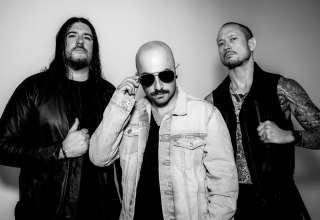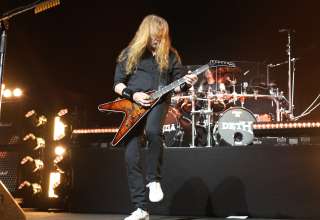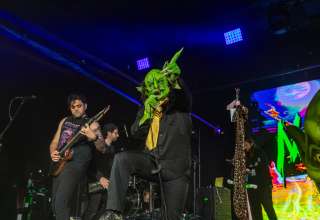Review & Photography by Manny Manson for MPM
The air inside Rock City was electric before Sophie Lloyd even touched a note. The crowd pressed together, bodies humming in anticipation, stage smoke curling like restless spirits. Sophie emerged first, guitar low, eyes focused yet playful, every movement exuding decade of ambition. Marisa Rodrigues took centre stage, smiling, sticking her tongue out, posing with mischievous confidence. Christian Rivers on rhythm guitar, Iman Ahmed on bass, and Christopher Painter on drums completed the ensemble, a tightly wound unit ready to ignite the venue.
Sophie’s trajectory had been relentless: from YouTube covers in a bedroom to collaborations with Machine Gun Kelly, Lzzy Hale, Michael Starr, and performing at the 2025 Women’s Rugby Union World Cup final against Canada. Every chord, every solo tonight was evidence of her evolution, now proven herself capable of commanding large stages, every lesson learned ever visible in her stagecraft: precise riffs, melodic solos and the ability to get the room light in their loafers.

The set opened with “Top Gun” (Intro) (Harold Faltermeyer & Steve Stevens, 1986, Top Gun soundtrack). The soaring synth lines became guitar harmonics and rapid alternate picking under Sophie’s fingers, bending and sliding with cinematic tension, harmonics ringing like jet engines. Christopher Painter punctuated the crescendos with sharp snare hits; Christian Rivers layered melodic textures, and Iman Ahmed’s bass anchored the groove, transforming a film score into a live rock narrative. “Battleground” (Sophie Lloyd original, shortened live) throbbed with palm-muted verses throbbed like pistons and exploded with controlled chaos into the chorus. Sophie’s solo twisted through the melody like a story unfolding, hammer-ons, pull-offs, and slides adding narrative depth. Every instrument interacted perfectly: Rivers’ riffs weaving with Ahmed’s bass while Painter accentuated transitions with precise fills.

Then came “You Give Love A Bad Name” (Bon Jovi, Slippery When Wet, 1986, original vocals: Jon Bon Jovi). Marisa Rodrigues joined the band on stage and proceeded to deliver Bon Jovi’s iconic lines with playful swagger, grinning, posing, infusing her own style to the song whilst keeping to the songs original structure, Sophie’s guitar added slides, harmonics, and legato runs, turning familiar stadium rock riffs into something fresh. The crowd sang along in unison, obviously enjoying Sophie’s reinterpretation of this night club classic. “Hanging On” (Sophie Lloyd, Imposter Syndrome EP) allowed for a subtler interplay. Marisa’s phrasing of Lauren Babic’s original lyric, danced over Sophie’s responsive leads, every bend and slide deliberate. whilst “Won’t You Come” (Sophie Lloyd) drove a brighter, upbeat groove, riffs sharp and tight. Audience hands rose, moving with the rhythms as Sophie threaded licks from previous and those to come in later songs into her solo. Originally released with Marisa on vocals, you could feel the energy in her delivery

“Runaway” (Sophie Lloyd) extended riffs and solos, the forward driving riffs snapping cleanly as Marisa delivered vocals hooks with precision eliciting cheers from the very partisan crowd. Then “Thunderstruck” (AC/DC, The Razors Edge, 1990, original vocals: Brian Johnson) roared through Rock City A moment of pure stadium rock as Sophie, guitar upright, shredded through that familiar intro lick, the crowd chanting along as she did so, her smile broadening all the time. Marisa channelled Brian Johnson while performing acrobatic poses; Sophie twisted Angus Young’s riffs with harmonics, slides, and squeals, and high register bends on her signature, purple, Kiesel guitar. Painter on the drums accentuating the swing, locked in with Iman on bass, making the classic sound simultaneously familiar and yet novel.

“Delusions” (Sophie Lloyd) took a darker, more brooding tone. Marisa’s voice floated above, emphasizing every guitar bend, while Sophie added harmonic twists, the call and response passages between guitar and vocal standing out as this Sophie original ripped from the PA. “Imposter Syndrome” (Sophie Lloyd, EP title track) escalated tension; motifs from earlier songs threaded into live solos, Marisa accentuating every line with leaps, spins, and playful theatrics, originally sang by that powerhouse LZZY Hale.
“Let It Hurt” (Sophie Lloyd), mid-tempo and emotive, showcased Sophie’s precision in bends and sustain. Marisa once again danced and posed, connecting with the audience, this song originally released with Chris Robertson from Black Stone Cherry on vocals lost none of its expressive dynamic. Sophie’s guitar solo (Sophie Lloyd) became a narrative on six strings, hammer-ons, pull-offs, slides, and harmonics. Marisa stepped back as Sophie set about weaving a story that held the room captive.

Sophie easily slid into “Enter Sandman” (Metallica, Metallica, 1991, original vocals: James Hetfield). Sophie executed Hetfield’s vocal lines with acrobatic flair, with twisted riffs, harmonics, and bends helped to elevate the song and make it her own without losing its identity. Audience reaction was instantaneous, every clap, cheer, and chant reinforced the energy she commanded. The set finally concluded with “Do or Die” (Sophie Lloyd original), with soaring leads and harmonics over Marisa’s acrobatic vocals. By the end, Sophie had claimed Rock City, merging technical mastery with playful, precise stagecraft, melodic wizardry and controlled chaos.

The moment Sophie’s final chord faded, the room seemingly exhaled as if it had been holding its breath all night. Eventually, the stage darkened further, the lights lowering into amber pools as a single spotlight hit the flat of the empty stage. Søren Andersen took position stage right, guitar in hand, back-up vocals ready, Ash Sheehan seated behind his kit with flat cap tipped just so, and the audience could feel the air thrum with expectation. Glenn Hughes stepped into the glow, leather jacket catching the haze, red Nash guitars bass slung low with the Wolverhampton Wanderers logo prominent on the headstock, a subtle yet powerful emblem of his pride in the West Midlands. This was no support act, this was a living legend taking command, decades of history distilled into one commanding presence.

The first riff of “Soul Mover” (Soul Mover, 2005, original vocals: Glenn Hughes) cut through the smoke like a blade. From the moment Hughes plucked the opening bass line, the groove was unmistakable, a throbbing heartbeat that held the crowd in tension and release. Søren’s guitar danced around Hughes’ bass, echoing melodic motifs while improvising harmonic flourishes between choruses. Ash punctuated each measure with deliberate cymbal swells and syncopated snare hits, giving the song more depth than the studio recording. Hughes’ vocals floated over the instrumentation, rolling from gritty low passages to soaring high notes, each phrase carrying the weight of experience and soul.

Without pause, “Muscle & Love” (Hughes/Thrall, Hughes/Thrall, 1982, original vocals: Glenn Hughes) slashed into the room. Originally recorded with Pat Thrall, this song had always fused funk-rock aggression with melodic sophistication. On stage, Hughes’ bass lines were expanded, slides and ghost notes accentuating the groove, while Søren reimagined Thrall’s solos with blues bends, tremolo-infused passages, and occasional call-and-response licks with Hughes’ bass. Ash’s drumming alternated between precise double-time fills and subtle syncopation, making the live arrangement far more dynamic than the studio version. Hughes’ vocal phrasing danced around the original melody, teasing, stretching, and inserting bluesy improvisations that kept the audience guessing.

“Voice In My Head” (Glenn Hughes solo work) slowed the tempo, letting Hughes’ voice fill the room with delicate vibrato and nuanced inflection. The bass pulsed deliberately beneath Søren’s arpeggios, creating a dialogue between instrument and voice, while Ash added subtle ghost notes and cymbal taps to heighten tension. Every breath, every subtle bend in the fretboard, was audible in the venue’s acoustics, the crowd hanging on each micro-detail. It was intimate yet commanding, Hughes teaching decades of technique in real time.

The set rolled into “One Last Soul” (Black Country Communion, 2010, original vocals: Glenn Hughes), a song built for layered harmonics and vocal interplay. Originally conceived with Joe Bonamassa, Jason Bonham, and Derek Sherinian, its studio complexity was brought to life in a new way live. Hughes’ bass danced in melodic counterpoint with Søren’s guitar, threading through every vocal line. Ash accentuated chord transitions with rolling fills, never overpowering, always lifting. Hughes’ voice was commanding, yet playful, improvising vocal runs, inserting slides and bluesy inflections that weren’t on the recording. Audience members murmured recognition as the riffs curled into unison, the energy swelling with every chorus, heads nodding like a sea of Churchill bulldogs on a cobbled street.

“Can’t Stop The Flood” (Building the Machine, 2001, original vocals: Glenn Hughes) was a study in deliberate tension. The bass held each note longer, allowing overtones to bloom, while Søren’s guitar carved minor key lines that hung between anticipation and release. Ash’s drums were surgical, punctuating without dominating. Hughes’ phrasing carried personal history, the lyrics a reflection of battles fought, addictions overcome, rebirth distilled into melodic lines. Each chorus growing subtly, building toward a cathartic payoff that the studio recording only ever hinted at.

With “First Step Of Love” (Glenn Hughes solo work) and “Way Back To The Bone” (Trapeze, Medusa, 1970, original vocals: Glenn Hughes), Hughes drew the crowd into his past. “First Step Of Love” is rooted in his solo explorations post-Trapeze, a funk-driven powerhouse that live expanded into extended bass fills and improvisational guitar breaks. “Way Back To The Bone” had Hughes’ bass stepping forward, riffs re-voiced with harmonic accents, while Søren’s solos borrowed and twisted original melodic ideas into something alive and immediate. Audience members who had followed him from the early 70s erupted at recognition of familiar lines, a visceral nod to decades of rock history.

“Medusa” itself was transformed. Originally recorded with Mel Galley and Dave Holland, the live version included an extended bass intro, Hughes’ fingers sliding along the fretboard, plucking with a precision only decades of experience can afford. Søren’s guitar wove around him, harmonics and vibrato bending familiar riffs into new dimensions, while Ash’s drums accentuated syncopation, creating tension before the chorus exploded. Hughes’ vocals alternated between soulful croons and aggressive shouts, a textbook in dynamic storytelling. Every line reflected both technical mastery and survival, the song as autobiography of seeing a beauty in L.A’s Whisky A Go Go, and then being told to write a song about her by his Nan.

“Grace/Dopamine” (Glenn Hughes/Toni Iommi) got massive cheers from the crowd as Hughes introduced this collaboration with Iommi. Søren, naturally had a black SG for this one. Bass, drums and guitar locked in tight as the smooth riffs flowed from Søren’s fingers, I did look to see if he was wearing thimbles for full sonic authenticity. “Chosen” (Glenn Hughes, 2025) displayed Hughes’ songwriting prowess. Bass, guitar, and drums locked in tight, riffs looping and unfolding like organic conversation. “Chosen” became a call to destiny; Hughes’ voice soared, Søren’s solos darting and bending in perfect tandem, Ash punctuating each phrase with percussive precision. Audience participation heightened, hands waving, voices rising, creating a feedback loop of energy — Hughes feeding them energy, the crowd amplifying it back.

“You Are The Music” (Glenn Hughes/) was both homage and manifesto, a celebration of the art form in itself. Hughes’ bass hummed melodically, almost like a conversation with itself, the guitar, counterpoint, weaving around vocal improvisations, responding to the call and return phrasing. Ash accentuating with subtle ghost notes, full of punctuation and authority. Live, Hughes seemingly expanded the bridge with vocal runs, teasing the audience, pulling them into his world. “Stay Free” (Glenn Hughes solo work), final main-set number, closed the main set with a triumphant energy. Bass riffs were extended, solos dissected into micro-moments, drums punctuating crescendos, Hughes’ voice both authoritative and playful, commanding Rock City with decades of cumulative experience.

The encore opened with “Coast To Coast” (Glenn Hughes acoustic solo). Every subtle nuance, every harmonic, every vocal inflection was exposed. Hughes plucked notes delicately, voice floating above, Ash and Søren absent save for ambient fills, leaving the audience suspended in intimate attention. “Black Country” (Glenn Hughes solo work) returned with its full power, riff-heavy, wall of sound. The bass carving the song’s heartbeat, West Midlands pride evident in every phrase. It propelled the energy towards the nights climactic end

Finally, the obvious finish to the night, “Burn” (Deep Purple, Burn, 1974, original vocals: David Coverdale & Glenn Hughes) unapologetically, became the apex of the night. Sophie Lloyd, glowingly introduced by Hughes, returned, fingers flying, bending notes in soaring harmonics, vaulting from Ash Sheehan’s drum riser alongside Søren Andersen, perfectly synchronizing with Sophie’s leads. Hughes’ bass roared beneath, plucking every note with authority, his vocals weaving between Coverdale-style growls and his own signature phrasing. The final solo stretched into a masterclass of harmonic bends, alternate picking, and sustained feedback controlled to perfection.

The stage became a swirl of motion: Sophie leaning and twisting as she shredded, Søren trading riffs with bass in joyous dialogue, Ash punctuating every explosion with percussive finesse. The crowd’s roar became a wall of sound, echoing through every corner, the final chord holding longer than reason, the energy pure catharsis.
Every note of Glenn Hughes’ 2-hour set, was a lesson in mastery, basslines alive, riffs inventive, solos expanded, vocals imbued with decades of experience and emotion. Stage interaction, improvisation, harmonic choices, and rhythmic nuance displayed a musician who had survived it all, thrived, and returned night after night with unrelenting energy. Rock City was transformed, Sophie’s virtuosity providing prelude to Hughes’ monumental presence, a full spectrum of rock from youthful ambition to seasoned mastery. I was there, every riff, solo, bend, and acrobatic leap etched into memory, fans dream made fresh.







